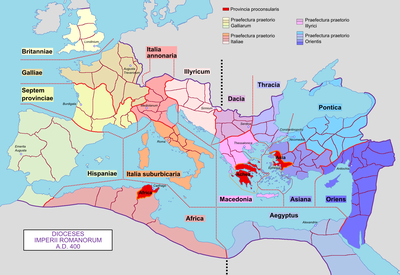Dioecesis Italiae Suburbicariae
The Dioecesis Italiae Suburbicariae was a late antique administrative unit ( Dioecesis ) of the Roman Empire . It existed from 395 AD until the reforms of Justinian I in the 530s.
Territory structure
The Dioecesis Italiae Suburbicariae comprised the following 9 provinces:
- Picenum suburbicarium
- Apulia and Calabria
- Lucania et Bruttium
- Samnium
- Sicilia
- Corsica
- Sardinia
- Valeria
- Campania
history
Italy had been divided into regions since Augustus . Only in the course of the Diocletian reforms was the whole of Italy divided into fixed administrative districts, which differed from the provinces only in that the title corrector, which was already known in Italy, was partially retained for their governors . But they received the full power of the other provincial governors, so that they exercised civil and criminal justice and took over the entire administration. Already with the division of the empire in 395 , the structure of the dioceses was changed into four prefectures, 15 dioceses and 119 provinces. "Italia" was divided into the dioceses Italia Annonaria and Italia Suburbicaria, which were subordinate to the praefectura praetoria Italiae (et Africae) . The diocese existed (albeit with a decreasing extent) under the Rex Italiae Odoacer and the Ostrogoths until Justinian I's imperial reforms in the 530s.
Individual evidence
- ↑ Werner Eck : The state organization of Italy in the high imperial era (= Vestigia . Volume 28). CH Beck, Munich 1979, p. 2.
- ^ Toni Glas, Udo Hartmann: The provincial administration. In: Klaus-Peter Johne (Ed.): The time of the soldiers' emperors. Crisis and transformation of the Roman Empire in the 3rd century AD (235–284). Volume 1, Akademie-Verlag, Berlin 2008, pp. 641–672, here p. 668.
literature
- Timothy David Barnes : The new empire of Diocletian and Constantine. Harvard University Press, Cambridge (MA) 1982, ISBN 0-674-61126-8 , pp. 201-208.
- Theodor Mommsen : Directory of the Roman provinces drawn up around 297. In: Treatises of the Berlin Academy of Sciences. Phil.-hist. Class . 1862, pp. 489-518 ( digitized version ).
- Otto Seeck : Notitia dignitatum: accedunt Notitia urbis Constantinopolitanae et laterculi provinciarum. Weidmann, Berlin 1876, pp. 247-251 ( digitized version ).

